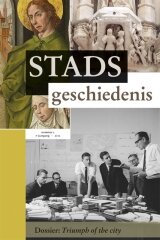Stadsgeschiedenis editie 2012 - 2

|
Jelle Haemers Tim De Doncker Tim Verlaan (Dossier) Triumph of the City door Edward Glaeser (Review) Jelle De Rock (Review) Bruno Blondé e.a. (Review) Jan Hein Furnée, Manon van der Heijden en Tim Verlaan |
Abstracts
Jelle Haemers, Blood and ink. New insights in revolt and violence in Leuven, 1360-83
This article reconsiders the revolt of Leuven, which took place from 1360 until 1383. Contrary to the opinion of many scholars, it argues that the rebels of Leuven, mainly craftsmen, were not inclined to use violence against the urban elite during this turbulent period. By means of petitions, the rebels primordially tried to gain peacefully rights of political participation, which they obtained in the end. Therefore, the Leuven revolt demonstrates that late medieval political conflict cannot be reduced to the ‘bloody’ violence used. For a study of the documents of the Leuven rebels, written in ink, shows that they had sophisticated ideas on how their city should be governed.
Tim De Doncker, Forging strategies. Gold and silversmiths in eighteenth-century Ghent between guild and art academy
Faced by consumers’ new demand for fashionable, quality goods, design skills became increasingly important for manufacturers since the second half of the seventeenth century. Across Europe, art academies and drawing schools were established with the aim of countering a design deficit. This article examines the effect that academy attendance had on a typical, middling, urban group: the gold- and silversmiths of late eighteenth century Ghent. The analysis demonstrates that the legitimation of skills topped the curriculum alongside their production; and that as a result, the eldest sons of masters especially benefited from the academic training.
Tim Verlaan, The concrete liaison of Hoog Catharijne. Citizens, local administrators and a private developer in Utrecht 1962-1973
This article examines the dynamics between a private developer, local administrators and citizens in the Dutch city of Utrecht during the construction of the privately initiated shopping and business centre ‘Hoog Catharijne’ (1962-1973). At the time of its conception virtually each and everyone praised this inner city redevelopment project, but by the late-1960s several protest groups came to the fore. Simultaneously the municipal executive wanted to offer its citizens joint decision making in spatial planning. These democratizing tendencies increasingly collided with the technocratic stance of the private developer involved. By systematically analyzing how this developer, local administrators and citizens positioned themselves in- and outside of the political arena, the growing democratic tensions in a period of rapid societal modernization will be investigated